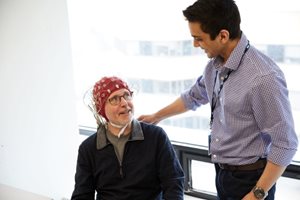Electroencephalography
Electroencephalography (EEG) is a common and cost-effective tool to assess a person’s brain activity in clinical and research settings. EEG involves placing electrodes on a person’s scalp (often held in place by a cap) to non-invasively detect changes in brain activity occurring within a few milliseconds. EEG can measure brain signals that arise in response to external stimuli, such as sounds, images, touch, or while a person rests or performs a mental task without external stimulation.
 Researchers and clinicians may use EEG to identify whether a person’s brain shows signs of disease or damage. For example, researchers at the Rotman Research Institute explore whether EEG can identify individuals who are at risk of developing dementia. The researchers measure brain activity at rest and during cognitive tasks, such as memorizing pictures, to detect the risk of developing dementia. This research has the potential to improve clinical care through the development of an easy-to-use and accessible screening tool that could also monitor the benefit of interventions designed to improve cognitive function.
Researchers and clinicians may use EEG to identify whether a person’s brain shows signs of disease or damage. For example, researchers at the Rotman Research Institute explore whether EEG can identify individuals who are at risk of developing dementia. The researchers measure brain activity at rest and during cognitive tasks, such as memorizing pictures, to detect the risk of developing dementia. This research has the potential to improve clinical care through the development of an easy-to-use and accessible screening tool that could also monitor the benefit of interventions designed to improve cognitive function.
At Baycrest, we use a variety of different EEG systems, including stationary, multi-channels EEGs (e.g., BioSemi, Neuroscan) and mobile EEGs (e.g., Muse, Cognionics).
Learn more about Baycrest research using EEG:
More evidence that musical training protects the brain
The EEG (and MEG) equipment was obtained through the University of Toronto Functional Imaging Research Network (FIRN) with more than $21 million of matched funding from the Canada Foundation for Innovation and the Ontario Innovations Trust. The Baycrest portion of this grant was more than $3 million.